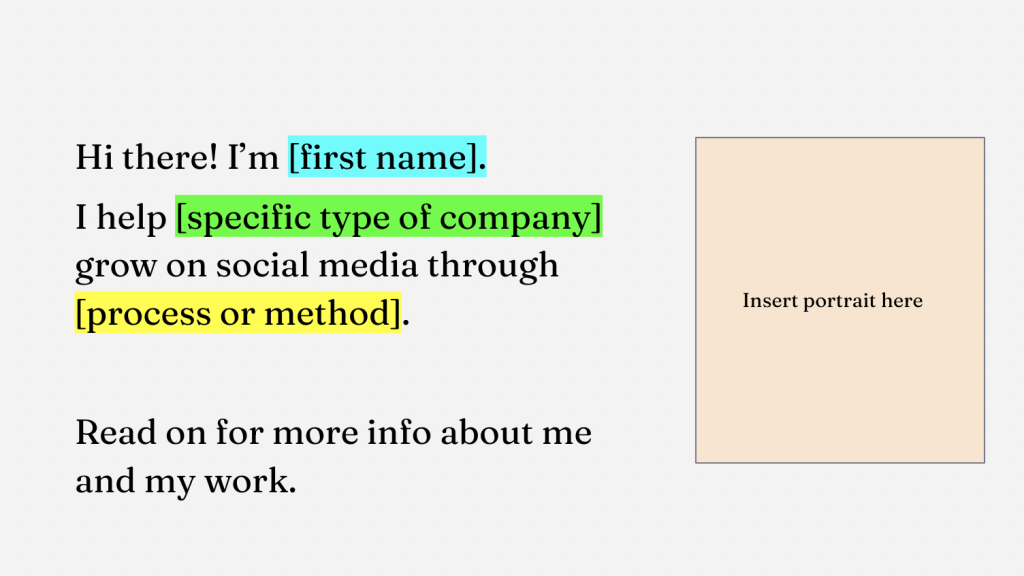It’s time to go pro
A social media portfolio is crucial to landing lucrative gigs as a freelancer, agency owner, or in-house social media professional.
Without a portfolio, you’re asking potential clients to hire you without any evidence that you can deliver for them.
And with potentially thousands of dollars at stake, that’s too much of a risk for any client to take.
It’s time to stop leaving money on the table.
Read on for expert tips on:
- Why you need a social media portfolio
- How to create a portfolio step-by-step
- The different formats you can create
- How to write killer case studies
- How to structure your portfolio
- Tips to keep in mind
👉🏽 P.S. Need to get started immediately? Grab the social media portfolio template here.
Table of contents
Jump to any section quickly:
- Definitions
- Why you need a social media portfolio
- Types of social media portfolio formats
- Get the social media portfolio template
- What your portfolio should include
- How to write killer case studies
- Steps to create a social media portfolio
- Wrap up
Definitions
Let’s start this guide with some definitions relevant to social media management and digital marketing.
A social media portfolio is an easily accessible collection of your previous social media experience.
A social media portfolio gives a potential client a broad overview of who you are, what you do (and don’t do) with social media, how you work, and who you’ve worked with.
Every social media manager should have a social media portfolio — especially if they’ve actively managed several social media profiles.
A case study is an in-depth analysis of a specific project or social media campaign you’ve worked on.
It highlights the problems you solved, the approach and solution, the team structure, and any results and metrics you tracked.
⚡ We’ll explain how to write a case study using the PASTOR method later in this guide.
Why you need a social media portfolio
A social media portfolio is a great way to sell your services. Specifically, a social media portfolio helps you to:
- Highlight your career journey: Your social media portfolio helps clients understand what niches you’ve worked in, which clients you’ve worked with, and any awards you’ve won. This builds credibility and helps sway their decision toward hiring you for a social media project.
- Showcase your social media skills: Social media is a broad field, and you likely haven’t mastered every skill in the industry. A social media portfolio lets you indicate what you’re best at, be it social media strategy, copywriting, graphic design, analytics, paid media, or community management. I’ve previously written about different social media careers you can explore, so read up on that if you’re unsure which path to take.
- Beat the competition: Social media management is a competitive sector. However, most social media specialists and freelancers won’t bother creating a social media portfolio, so you stand out by having one. This helps you win new jobs more easily.
- Justify your rates: After receiving your proposal or quote, clients may have questions about the value they’ll get. A social media portfolio can convince them you’re worth the money.
- Set expectations: Your social media portfolio specifies how you work — including what you’ll do and won’t do. This aligns everyone and minimizes the risk of disagreements later.
However, not all social media portfolios are created equal.

5 types of social media portfolio formats
Depending on your needs, graphic design abilities, and the prospective client you’re dealing with, you may have to create one or more formats for your social media portfolio.
These include:
- Social media channels: As a social media manager, your social media account is the first place an ideal client checks. You can use your social media presence (such as an Instagram account) to showcase projects you’ve previously worked on.
Use a social media platform like LinkedIn or Instagram to create carousel posts (a high-converting type of social media post) that act as mini-slideshows for your previous work. You can also share more details in your Stories.
` - Slideshow portfolio: Slideshows are beautiful, easy to make, and don’t require any special software to run. You can create a social media portfolio using Google Slides and link to it from anywhere. If you have a website, create a simple redirect rule to your slideshow portfolio for a cleaner link.
For example, if your social media portfolio slideshow is hosted at google.com/slides/alphanumeric-url-123, you can create a redirect rule on your website using the URL suffix /portfolio. That way, when someone clicks on yourwebsite.com/portfolio, they get redirected to the correct slideshow.
The benefit here is you can edit your portfolio freely, switch to a different format or platform, and never have to change the link. Just edit the redirect rule on your website, and it’ll continue working normally.
I use 301 Redirect for WordPress — but you can use any plugin you like. You can also create similar rules for Wix, Carrd, and Shopify.
` - Webpage portfolio: A landing page or blog post is another way to create an easily accessible social media portfolio. With this route, you needn’t bother with redirect links — just create the page and share the URL.
You can edit the page as often as you like, and clients will always see the latest version of your social media marketing portfolio.
You can create a simple portfolio page in WordPress, Wix, or Carrd. If you’re strapped for cash, go with Carrd — it’s free, dead simple, and works like a charm.
` - Online portfolio builder: If you’d rather not fiddle with webpages or links, you can create a social media marketing portfolio on an online portfolio website like Copyfolio or Behance. On a portfolio site, you needn’t be a web developer to create a great portfolio of previous client work.
Simply prepare the text, images, and screenshots you need, and create individual case studies on your chosen portfolio platform. I’d suggest backing up all your case study content to a Google Doc for future reference.
` - PDF (Adobe portfolio): Sometimes, you need to create a social media portfolio PDF. This may be required when applying for jobs that insist on a PDF upload and don’t have an input field for links. It can also be useful for clients who need to print out and showcase your portfolio internally.
To create a social media portfolio PDF, use Canva (easier and less technical) or create an Adobe portfolio using InDesign (more challenging but greater control).
Here are some examples of social media portfolio PDF templates for Canva and InDesign, respectively.
⚡ P.S. Grab the social media portfolio template for 10% off! I created a premium social media portfolio slideshow template just for this post. The template is complete, beautiful, and ready to use. Simply make a copy of the template to your drive to get started immediately. Edit the text and delete what you don't need. You can also export it as a PDF easily — more choice for the same price. Use the code SOCIAL for 10% off. Grab it 👉🏽 here. 👈🏽
Read on for what your social media portfolio should include.

What your social media portfolio should include
You know why you need a social media portfolio and the different types you can create, but what should a winning portfolio template include?
These are the key elements to a great portfolio — in no particular order:
- Introduction and story
- Professional headshot
- Contact details
- Certifications
- Case studies
- Testimonials
- Services
- Process
- Niche(s)
- Awards
- Skills
Let’s dig into each one.
Introduction and story: Why do you do what you do?
While optional, your backstory is a great way to connect with potential clients. Use this section to highlight your path into social media management.
You can indicate whether you came from another career, taught yourself social media, or simply wanted to change how social media gets done.
This is the “getting to know you” part of your portfolio.

Professional headshot: Say cheese! 😁
A good headshot adds warmth to your portfolio. Smile, use a clutter-free background, and dress nicely.
You can hire a photographer to take professional headshots of you or simply ask a friend to shoot your portrait against a white wall.
First impressions last, so make it a good one.
Contact details and links: How can people get in touch with you?
Make it easy for clients to reach out and hire you. Include your contact details (typically email and phone number) and links (typically as social media icons) to your online accounts or newsletter, if you have one.
The reason for this is simple: even if a prospective client doesn’t hire you right away, it’s good to always keep potential clients in your orbit.
You never know when they might need a social media manager in the future.
Certifications: What have you formally studied?
Certifications confer credibility, so include any social media-related certifications and degrees you have.
This can include a marketing or PR degree, bootcamps you’ve attended, short courses you’ve taken, or professional training you’ve completed.
⚡ Don’t be afraid to include non-obvious certifications, too. For example, a statistics degree speaks to your social media analytics skills, while a graphic design certification indicates you can produce creative campaigns.
Case studies of previous campaigns: What have you done before?
Case studies are the bread and butter of every social media portfolio. Clients want to know who you’ve worked with, what you did for them, and what results you got.
If anything, spend more time on this part, as it’ll make or break your portfolio.
What if I haven’t done any previous work?
Great question. This challenge is common if you’re just starting out or unable to share case studies of previous works due to an NDA.
If this is the case, you’ll need to put speculative work into your portfolio.
Speculative, or spec work, is work that hasn’t been commissioned by a paying client. It’s work you created to showcase what you’re capable of in the hopes you’ll get paid for it later.
Think of graphic designers designing brand identities for fictional (or well-known) brands for their design portfolio or copywriters writing fictitious ad campaigns for their favorite brands.
Spec work helps you kickstart your social media management career, so if you don’t have any previous work experience, create it yourself.
For example, find a friend launching a brand and do social media marketing for them, then include it in your portfolio.
Do a mock campaign for your favorite shoe, clothing, or car brand and include it, too.
⚡ Indicate clearly that it’s spec work to avoid confusion. As you bring in paid work, you can slowly replace the spec work in your social media portfolio with real-life campaigns.
How many previous campaigns should I include in my social media portfolio?
It depends on the types of clients you work with. If you’re an agency, you’ll want a diverse range of case studies to show you can work across different verticals and campaign budgets — think 5-7 case studies.
If you’re a social media manager, freelance writer, or social media graphic designer, 2-3 case studies are fine. The key is to include case studies the client or potential employer can relate to.
⚡ Try and include relatable case studies in your social media portfolio. There’s no point in including a case study about a $100,000 paid media campaign when pitching social media marketing strategy to a mom-and-pop shop.
How to write a digital marketing or social media case study using the PASTOR method (with examples)
You can use the PASTOR method to speed up case study writing. PASTOR stands for:
- Problem
- Approach
- Solution
- Team
- OKRs
- Results
Just as real-life pastors convert non-believers into believers, the PASTOR case study method converts skeptical prospects into long-term retainers.
Let’s dig into each element of the PASTOR method.
#1 Problem
Every campaign starts with a problem or challenge. A company might be trying to grow its audience, run a promotion, connect with its community, run paid ads, or track brand mentions online.
Something prevented them from reaching their goals, such as a lack of expertise, resources, or time. That’s why they reached out to you.
In your case study, outline the problem you had to solve. For example:
Acme Clothing had a large social media following, but was struggling to increase engagement and drive traffic to their website.
They wanted to find a way to better connect with their followers and encourage them to take action.
#2 Approach
Clients want to know your approach to getting results.
Perhaps you take time digging into customer data, gamify communities to drive engagement, use special tools in your work, or have a special philosophy around ads.
Detail your approach in the case study, outlining what you considered. For example:
To address this problem, we focused on creating high-quality, relevant content that resonated with our target audience.
We also explored videos, polls, and live streams, to see what received the most engagement.
In addition, we mapped out a paid advertising campaign to reach a wider audience and drive traffic to the website.
#3 Solution
Talk about your chosen solution and why it was the best way forward. Clients with similar challenges will want to know if your solution can solve their problems. For example:
Based on our analysis of the data, we developed a social media strategy that included a mix of curated and original content across a variety of post formats, bolstered by a paid advertising campaign.
We also worked with a key influencer in our target market to create sponsored content and promote our brand.
#4 Team
Social media is typically collaborative. Describe the team that worked on the project, include their roles and responsibilities, and outline how you contributed to the project’s success. This gives a sense of the expertise and resources that were needed to solve the problem. For example:
The team working on this project included a social media strategist, content writer, and graphic designer.
The social media strategist oversaw the execution of the campaign, while the content writer wrote the posts and the designer created visual assets.We worked on this campaign over three weeks.
#5 OKRs
OKRs, or objectives and key results, are the specific goals and metrics used to measure the success of a project. This includes things like increased sales, increased engagement, or improved efficiency.
Outlining a project’s OKRs provides a clear sense of what was achieved and how it was measured. For example:
The OKRs for this project included increasing website traffic from social media by 30% within the first three months and increasing engagement on our social media accounts by 20% within the first six months.
#6 Results
Finally, discuss the results the project achieved. This could include quantitative and qualitative data, such as increased traffic to a website, higher sales, or improved customer satisfaction.
The results are the most important part of a case study, as it shows the tangible impact of your work. For example:
As a result of our efforts, Acme Clothing saw a 35% increase in website traffic from social media within the first three months.
We also saw a 25% increase in social media engagement within the first six months, plus a 29% increase in follower count.
Overall, our social media campaign was successful in driving traffic to the website and increasing engagement with our followers.
However, finding results to share is not always easy. Social media professionals are often cut off from the downstream results of their campaigns, so these stats might be hard to find.
For example, you may have spent weeks running an ad campaign without any visibility into the sales impact of your efforts. In such cases, you can speak to client satisfaction with your campaign assets instead.
Overall, the PASTOR method is a useful framework for creating impactful case studies that showcase your problem-solving abilities and the value you bring to your clients.

A few more tips to keep in mind
- Sort your case studies by category: If you have lots of case studies, sort and label them into different categories, such as strategy, copywriting, design, paid media, and community management
- Show, don’t tell: Add pictures of your creative assets and screenshots of the data or feedback you collected
- Add durations: Indicate the length of each campaign or client engagement for reference
- Add links: Where possible, link to the campaign posts for reference
⚡ Reminder: the social media portfolio template already has these sections built in. Simply duplicate the slides you want and fill in the necessary information. It's never been easier to showcase your work than right now. Grab it here.
Testimonials
Testimonials from previous clients can tip the scales in your favor. Clients know you’re biased, so they’re more willing to trust a third party about your abilities than your own claims.
To gather testimonials, reach out to previous clients and ask for thoughtful reviews about the work you did for them. Where possible, get them to give you that testimonial on LinkedIn as a recommendation.
This kills two birds with one stone: it improves your LinkedIn profile and provides permanent testimonials you can copy to other places such as your social media portfolio PDF or your website.
Services
No social media manager can do everything well. Some specialize in crafting content, others excel at community management, and others are better at paid media.
Use the Services section of your social media portfolio to list your top services and base prices. This gives prospective clients an idea of what you can deliver and how much it’ll cost.
Process
Every social media manager has their own process for social media marketing. This can include specific:
- Tools: There might be specific tools you use in your work often, such as Publer, Buffer, or Zapier
- Research processes: Maybe you prefer to do a few customer interviews or insist on a social media audit first
- Do’s and don’ts: You might specify what you do and don’t to set expectations
- Communication process: You may be more partial to email and Slack than phone calls and text messages
- Creative process: Perhaps you do mockups and sketches and always require sign-off before publishing
Whatever the details, describe your process to show professionalism and puts your client’s mind at ease.
Niches
You’re likely great at one or two niches and pretty mid at the rest. One social media manager might be a pro at B2B LinkedIn marketing for sales-led startups, while another is a wizard at Instagram marketing for D2C e-commerce companies.
If you’ve already identified your niche, indicate it in your social media portfolio to attract best-fit clients and repel the rest.
Awards
Like certifications, awards confer credibility on your skills as a social media manager. If any previous campaigns have won awards, indicate that in your social media portfolio. (Feel free to then change your LinkedIn bio to “award-winning social media marketer.”)
Skills
Which social media skills are you best at? You might be great at social media strategy but care nothing for community management.
Perhaps you rock at running paid ads but aren’t interested in organic social media content creation. Assess your skills honestly and indicate your strongest suit in your social media portfolio.
How to create a social media portfolio step-by-step
We’ve covered the different types of social media portfolios and why you need one, so let’s look at how to create a digital portfolio step by step:
- Choose the platform or format you want to use — a website, social media account, slideshow, or PDF
- Add a professional headshot to the page, presentation, or PDF
- Include a table of contents where possible to make it easier to scan your portfolio
- Include case studies using the PASTOR method
- Add other elements such as testimonials, awards you’ve won, skills, and certifications
- Add your contact details and link to your social media accounts
- Export the PDF (if using Slides, Canva or InDesign) or publish the webpage or online portfolio
- Create a link redirect using 301 Redirect, bit.ly, or any other tool you’re comfortable with
- Share the link with prospective clients!
⚡ Skip the manual work and use a ready template. Simply make a copy of the social media portfolio template to your Google Drive and fill it in. Grab it 👉🏽 here. 👈🏽
Create an impressive social media portfolio today
A social media marketing portfolio is a crucial part of your sales process as a social media professional.
With a digital portfolio, you can share your experience more widely, convert more prospects into customers, charge more for your services, and highlight your top skills.

The tips in this guide apply whether you’re a journalist, creative professional, freelance writer, or digital marketer building a journo portfolio, graphic design portfolio, content marketing portfolio, or digital marketing portfolio.
Use these tips to create a stunning social media portfolio that wows potential clients every time. Share this ultimate guide with a social media manager today!
Next, check out my guide to building an effective digital marketing portfolio.

Mohammed Shehu, Ph.D. writes on content and marketing for creators and brands. You can find him online @shehuphd everywhere.
